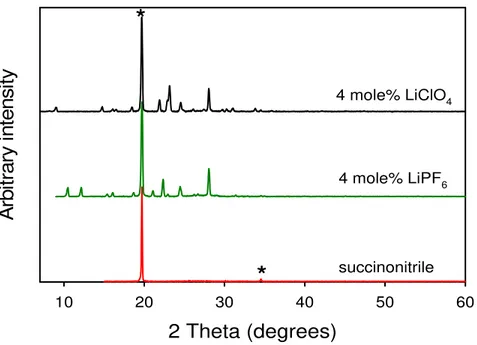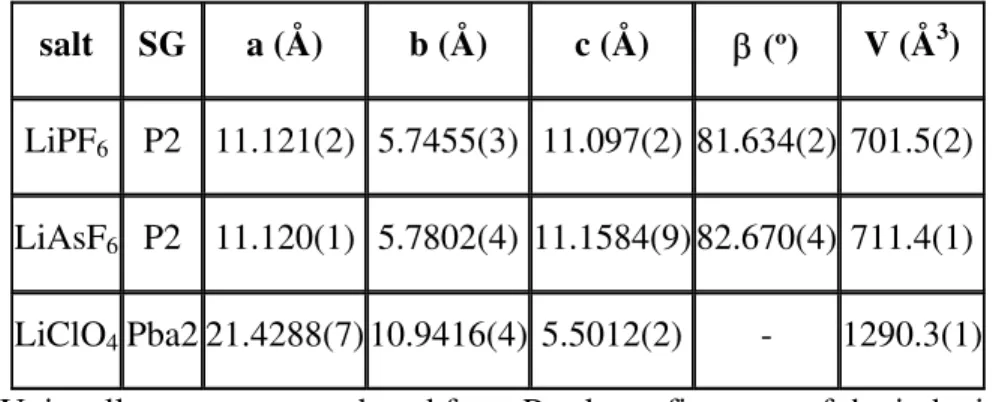Publisher’s version / Version de l'éditeur:
Proceedings of the 55th Annual Conference on Applications of X-ray Analysis, 2007, 2007
READ THESE TERMS AND CONDITIONS CAREFULLY BEFORE USING THIS WEBSITE.
https://nrc-publications.canada.ca/eng/copyright
Vous avez des questions? Nous pouvons vous aider. Pour communiquer directement avec un auteur, consultez la première page de la revue dans laquelle son article a été publié afin de trouver ses coordonnées. Si vous n’arrivez pas à les repérer, communiquez avec nous à PublicationsArchive-ArchivesPublications@nrc-cnrc.gc.ca.
Questions? Contact the NRC Publications Archive team at
PublicationsArchive-ArchivesPublications@nrc-cnrc.gc.ca. If you wish to email the authors directly, please see the first page of the publication for their contact information.
Archives des publications du CNRC
This publication could be one of several versions: author’s original, accepted manuscript or the publisher’s version. / La version de cette publication peut être l’une des suivantes : la version prépublication de l’auteur, la version acceptée du manuscrit ou la version de l’éditeur.
Access and use of this website and the material on it are subject to the Terms and Conditions set forth at
Structure determination from powder diffraction data of some moisture-sensitive network coordination compounds
Whitfield, P. S.; Abouimrane, A.; Davidson, I. J.
https://publications-cnrc.canada.ca/fra/droits
L’accès à ce site Web et l’utilisation de son contenu sont assujettis aux conditions présentées dans le site LISEZ CES CONDITIONS ATTENTIVEMENT AVANT D’UTILISER CE SITE WEB.
NRC Publications Record / Notice d'Archives des publications de CNRC: https://nrc-publications.canada.ca/eng/view/object/?id=5e7d74e9-8bdb-4de3-b0da-3e149f8eee6a https://publications-cnrc.canada.ca/fra/voir/objet/?id=5e7d74e9-8bdb-4de3-b0da-3e149f8eee6a
P.S. Whitfield, A. Abouimrane, and I.J. Davidson
Institute for Chemical Process and Environmental Technology, National Research Council Canada, 1200 Montreal Road, Ottawa, Ontario, K1A 0R6, Canada
ABSTRACT
A series of new compounds was discovered during the study of a novel solid lithium-ion battery electrolyte system based on succinonitrile. The phases LiX(succinonitrile)2 (X = PF6-, AsF6-, ClO4-) were identified as undesirable phases that formed at low salt concentrations in succinonitrile. The silver analogues of these systems also exist as crystalline phases, but the lithium salts do not share the same structure. The crystal structures of the Li salts were solved from laboratory X-ray diffraction data. The AsF6- and PF6- adducts are isostructural, with the monoclinic space group, P2. The ClO4- adduct has a doubled unit cell volume compared to the AsF6- and PF6- materials and has the orthorhombic space group Pba2. The lithium coordination in these adducts helps explain why plastic crystal electrolytes using LiPF6 and LiClO4 salts have poor ionic conductivity at room temperature.
INTRODUCTION
Although lithium-ion batteries dominate the market to power portable consumer electronics, the technology is far from perfect. Currently, the electrolyte is a lithium salt dissolved in organic solvents, usually carbonates such as dimethyl carbonate and ethyl carbonate. The lithium salt most widely used is LiPF6, which easily forms corrosive HF on exposure to moisture. The flammable organic solvents are a concern, as excessive heat can be generated if a short circuit occurs. Consequently, much effort has been put into finding alternative electrolytes. The ideal electrolyte would be solid, while maintaining the good transport properties of liquid electrolytes. Finding such an electrolyte appears to be a difficult task, and as expected, most solid electrolyte systems do not perform as well as liquids at room temperature.
Materials known as 'plastic crystals' have interesting properties that may help achieve these apparently contradictory requirements. Plastic crystals are effectively the inverse of liquid crystals, i.e. they have positional order but orientational disorder (see Figure 1). This gives them a number of desirable properties, such as high plasticity and diffusivity. Succinonitrile (succ) has been identified as the potential base for an electrolyte due to its low intrinsic ionic and electronic conductivity, and suitable temperature range of plastic crystal stability from approximately -35 ºC to melting at 57 ºC. Doping with certain lithium salts has been shown to induce very high ionic conductivity (10-3 Scm-1) at room temperature [1, 2].
heat
Figure 1. Schematic diagram showing the transformation from crystal to plastic crystal on heating.
There should be very little difference in the conductivities obtained with different salts, given the expected Li+ conduction mechanism. However, this is far from the case, varying by more than 4 orders of magnitude at room temperature (10-7 S/cm for LiPF6 and 10-3 S/cm for Li[(CF3SO2)2N]), and X-ray diffraction studies were undertaken to see why the conductivity with certain salts was orders of magnitude lower than others.
EXPERIMENTAL
Initial work on the electrolyte systems involved the dissolution of lithium salts into molten succinonitrile. For X-ray diffraction work the molten material was injected into a 1mm borosilicate glass capillary.
In order to synthesize single phase adducts as powders, a solution route [3] was chosen to yield better particle statistics than a melt-processed sample. The succinonitrile and lithium salts were dissolved in ethanol, and the ethanol removed under vacuum in a glove-box antechamber. The products are extremely moisture-sensitive, so were loaded and sealed into 1mm borosilicate glass capillaries for X-ray diffraction analysis. The synthesis of the LiAsF6 adduct was also attempted as a possible heavy-atom analogue for the LiPF6 compound to aid in the structure solution.
The X-ray diffraction data were obtained using a Bruker D8 Advance equipped with a primary Göbel mirror and Bruker Våntec-1 PSD detector with radial Soller slits. The indexing was done using the singular value decomposition method [4] implemented in Topas 3 [5]. Although the variable count time approach was not used for the data collection, the higher angle reflections were weighted by 20-30X (to counter the loss in intensity from the form factor) in the structure solution and refinement. The succinonitrile and anion units were described in terms of Z-matrices. Simulated annealing [6] was carried out in Topas 3 on the peak intensities rather than full profiles for speed [5].
2 Theta (degrees) 10 20 30 40 50 60 A rbi tr ar y i nt ens it y 4 mole% LiClO4 4 mole% LiPF6 succinonitrile
*
Figure 2. X-ray diffraction patterns of 4 mole% LiPF6 and 4 mole% LiClO4 in succinonitrile compared with pure succinonitrile.
RESULTS AND DISCUSSION
The diffraction patterns of 4 mole% LiPF6 and LiClO4 electrolytes showed the presence of highly crystalline materials (Figure 2), which was unexpected at such a low salt concentration. A similar series of succinonitrile-based crystalline adducts was found in the literature [3]. Silver salts with the same anions (e.g. AgClO4, AgAsF6) were observed to form crystalline adducts with dinitriles such as succinonitrile and were studied using single-crystal X-ray diffraction techniques. Such silver salts are commonly used in the study of self-assembling network coordination compounds, which can be 3D interpenetrating networks, 2D planar systems or even 1D in nature. It was hypothesised that similar compounds may be formed with lithium salts. The same ethanol-based technique was used to synthesise single phase LiX(succinonitrile)2 as in the silver system. The X-ray diffraction patterns of the resulting white solids can be seen in Figure 3, confirming that the parasitic phases in the LiPF6 and LiClO4 plastic crystal electrolytes were indeed 1:2 salt:succinonitrile adducts. The diffraction patterns of the LiPF6 and LiAsF6 adducts were very similar, which suggested that they are isostructural. However, fitting the diffraction data from the lithium salts with the structures of the corresponding silver salts was unsuccessful, so the structures of the lithium series are distinct from the silver compounds.
The patterns were successfully indexed with the unit cells shown in Table 1. The LiXF6 lattices can also be described in terms of a doubled C-centred orthorhombic cell with a volume of approximately 1400 Å3.
Two theta (degrees)
10 20 30 40 50 60Arb
itrary
in
te
nsity
LiPF
6(succ)
2LiAsF
6(succ)
2LiClO
4(succ)
2Figure 3. X-ray diffraction patterns of LiClO4(succ)2, LiPF6(succ)2 and LiAsF6(succ)2.
salt SG a (Å) b (Å) c (Å) β (º) V (Å3)
LiPF6 P2 11.121(2) 5.7455(3) 11.097(2) 81.634(2) 701.5(2) LiAsF6 P2 11.120(1) 5.7802(4) 11.1584(9) 82.670(4) 711.4(1) LiClO4Pba2 21.4288(7) 10.9416(4) 5.5012(2) - 1290.3(1)
2Th Degrees 70 60 50 40 30 20 10 Co u n ts 1,100,000 1,000,000 900,000 800,000 700,000 600,000 500,000 400,000 300,000 200,000 100,000 0 -100,000
R
wp= 3.7%
24 refined non-H atoms
Figure 4. Rietveld difference plot and refined structure for LiPF6(succinonitrile)2
The final refinement difference plots and crystal structures are shown in Figures 4 and 5 for the LiPF6 and LiClO4 adduct respectively. The LiAsF6 adduct was found to have an almost identical structure to the LiPF6 adduct (Rwp = 5.6%); there was a minor LiAsF6 impurity. Each of the structures is a 3-dimensional network, as occurs in the silver analogues. Notable features in the LiPF6 and LiAsF6 adducts include the lithium being tetrahedral coordinated to succinonitrile nitrogens, and the succinonitrile units are all in the trans conformation forming a 3-dimensional network. The LiClO4-based adduct also had the lithium in tetrahedral coordination with nitrogen, but in this case one of the succinonitrile units was cis and the other trans; again forming a 3-dimensional network. There is more variability in the structures obtained with the lithium salts than the silver salts. Although the symmetry changes with different anions, the cell volumes per formula unit change little, and there are no smaller reduced cells apparent in the silver salts using ADDSYM or NEWSYM [7].
2Th Degrees 70 60 50 40 30 20 10 Co u n ts 200,000 190,000 180,000 170,000 160,000 150,000 140,000 130,000 120,000 110,000 100,000 90,000 80,000 70,000 60,000 50,000 40,000 30,000 20,000 10,000 0 -10,000 -20,000 ClO4 100.00 % ClO4 100.00 %
R
wpR
= 2.7%
wp= 4.2%
There appear to be few similarities between the structures discussed here and the crystalline electrolyte materials formed by lithium salts and polyethylene oxide (PEO) described by Bruce and Andreev [6]. The connectivity in the materials described here requires relatively small ligand molecules; the long chain PEO tending to form chains or helices. Ongoing work on the succinonitrile system suggests significant differences in the behaviour of succinonitrile with organic, non-symmetrical anions such as the imide electrolyte salt Li[(CF3SO2)2N], otherwise known as LiTFSI.
CONCLUSIONS
The crystal structures of three moisture-sensitive crystalline lithium salt adducts (LiPF6, LiAsF6 and LiClO4) with succinonitrile have been solved and refined from laboratory X-ray powder diffraction data. The tetrahedral coordination of the lithium with succinonitrile nitrogen atoms in a stable crystalline adduct removes mobile lithium from the succinonitrile matrix. This helps to explain the poor room temperature performance and ionic conductivity of the plastic crystal electrolytes using these salts.
REFERENCES
[1] Long, S.; MacFarlane, D.R.; Forsyth, M., Solid State Ionics, 2003, 161, 105-112.
[2] Abouimrane, A.; Abu-Lebdeh, Y.; Alarco, P.-J.; Armand, M., J.Electrochem.Soc., 2004, 151, A1028-A1031
[3] Carlucci, L.; Ciani, G.; Proserpio, D.M.; Rizzato, S., CrystEngComm, 2002, 4, 413-425. [4] Coelho, A.A., J.Appl.Crystallogr., 2003, 36, 86-95.
[5] TOPAS V3: General profile and structure analysis software for powder diffraction data. Bruker AXS (2005) Karlsruhe, Germany: Bruker AXS.
[6] Bruce, P.G.; Andreev, Y.G., "Solution of flexible molecular structures by simulated annealing", in Structure Determination from Powder Diffraction Data, Oxford University Press, Oxford, UK, 2002, 286-306
[7] PLATON, a multipurpose crystallographic tool. Spek,A.L. (2005) Utrecht, The Netherlands: Utrecht University.



